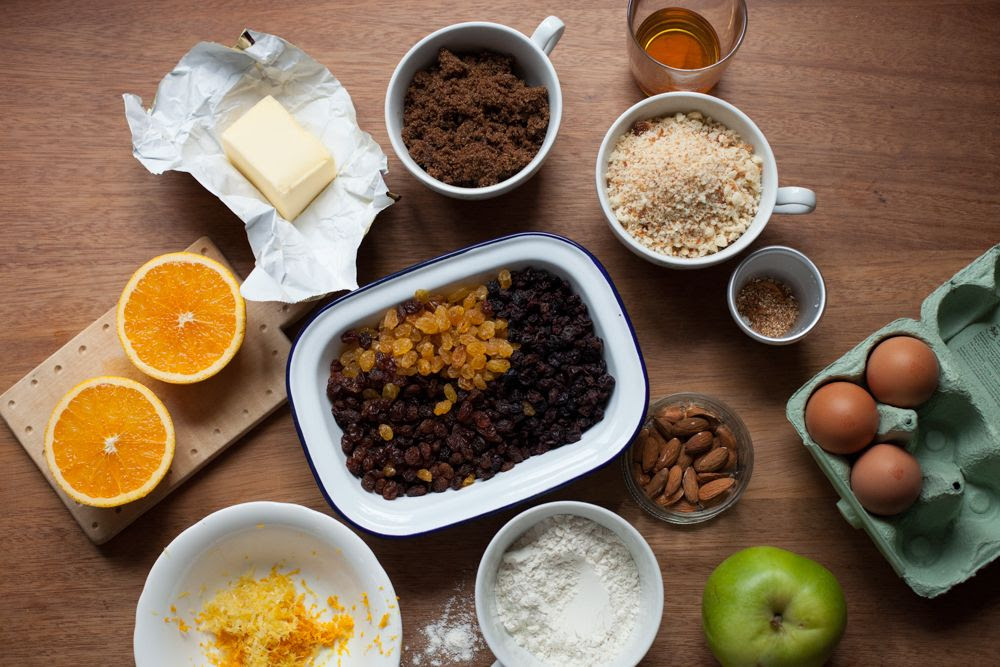
For Christmas this year, I decided to try making my first Christmas pudding. I chose to make it on Stir up Sunday - on the 24th November this year, Sunday before last - and mature it until Christmas Day, as the tradition goes. I wanted to participate properly - as a cook, rather than a blogger trying to get something ready for the holidays - so I decided to wait until another year to give you a recipe.
I still wanted to share some pictures of the process so I thought I would write something about the background of the Christmas pudding. When it comes to history, I can do no better than to refer you to Ivan Day's
three posts on Christmas puddings, so I thought we'd look at some literature instead.

The first literary mention of plum pudding at Christmas is in Anthony Trollope's
Doctor Thorne, published in 1858: "Miss Oriel's visit had been entirely planned to enable her to give Mary a comfortable way of leaving Greshamsbury during the time that Frank should remain at home. Frank thought himself cruelly used. But what did Mr Oriel think when doomed to eat his Christmas pudding alone, because the young squire would be unreasonable in his love?"
I've read a bit of
Doctor Thorne online and, essentially, Frank wishes to make an 'unreasonable' marriage to the girl he loves, Mary, instead of marrying for money. His family disagrees and Mary rebuffs his advances even though she feels the same way. When he returns home for Christmas, Mary has gone to London with her friend, Patience Oriel - leaving her brother sat alone at his festive table with a solitary spoon in the pudding dish.
Since Mr Oriel's lonely dinner, most mentions of Christmas puddings have revelled in the joy and chaos of the feast, with the cook's nerves and the guest's antics only adding to the warmth. These are my favourites:

"Harry had never in all his life had such a Christmas dinner. A hundred fat, roast turkeys, mountains of roast and boiled potatoes, platters of fat chipolatas, tureens of buttered peas, silver boats of thick, rich gravy and cranberry sauce - and stacks of wizard crackers every few feet along the table. {...} Flaming Christmas puddings followed the turkey. Percy nearly broke his teeth on a silver Sickle embedded in his slice. Harry watched Hagrid getting redder and redder in the face as he called for more wine, finally kissing Professor McGonagall on the cheek, who, to Harry's amazement, giggled and blushed, her top hat lopsided."
Harry Potter and the Philosopher's Stone, J. K. Rowling, Chapter 12.
"For dinner we had turkey and blazing pudding, and after dinner the Uncles sat in front of the fire, loosened all buttons, put their large moist hands over their watch chains, groaned a little and slept. Mothers, aunts and sisters scuttled to and fro, bearing tureens. Auntie Bessie, who had already been frightened, twice, by a clock-work mouse, whimpered at the sideboard and had some elderberry wine. The dog was sick. Auntie Dosie had to have three aspirins, but Auntie Hannah, who liked port, stood in the middle of the snowbound back yard, singing like a big-bosomed thrush."
A Child's Christmas in Wales, Dylan Thomas.

"But Clongowes was far away: and the warm heavy smell of turkey and ham and celery rose from the plates and dishes and the great fire was banked high and red in the grate and the green ivy and red holly made you feel so happy and when dinner was ended the big plum pudding would be carried in, studded with peeled almonds and sprigs of holly, with bluish fire running around it and a little green flag flying from the top. "
A Portrait of the Artist as a Young Man, James Joyce, Chapter 1.
"There never was such a Christmas dinner as they had that day. The fat turkey was a sight to behold, when Hannah sent him up, stuffed, browned, and decorated. So was the plum pudding, which melted in one's mouth, likewise the jellies, in which Amy revelled like a fly in a honeypot. Everything turned out well, which was a mercy, Hannah said, "For my mind was that flustered, Mum, that it's a merrycle I didn't roast the pudding, and stuff the turkey with raisins, let alone bilin' of it in a cloth."
Little Women, Louisa May Alcott, Chapter 22.

"But now, the plates being changed by Miss Belinda, Mrs Cratchit left the room alone - too nervous to bear witnesses - to take the pudding up, and bring it in.
Suppose it should not be done enough! Suppose it should break in turning out! Suppose somebody should have got over the wall of the back-yard, and stolen it, while they were merry with the goose: a supposition at which the two young Cratchits became livid! All sorts of horrors were supposed.
Hallo! A great deal of steam! The pudding was out of the copper. A smell like a washing-day! That was the cloth. A smell like an eating-house and a pastrycook's next door to each other, with a laundress's next door to that! That was the pudding. In half a minute Mrs Cratchit entered: flushed, but smiling proudly: with the pudding, like a speckled cannon-ball, so hard and firm, blazing in half of half-a-quartern of ignited brandy, and bedight with Christmas holly stuck into the top.
Oh, a wonderful pudding!"
A Christmas Carol, Charles Dickens, Chapter 3.
 Three of my favourite Christmas recipes:
Bûche de Noël
Father Christmas Gingerbread Cookies
Stollen Wreaths
Three of my favourite Christmas recipes:
Bûche de Noël
Father Christmas Gingerbread Cookies
Stollen Wreaths